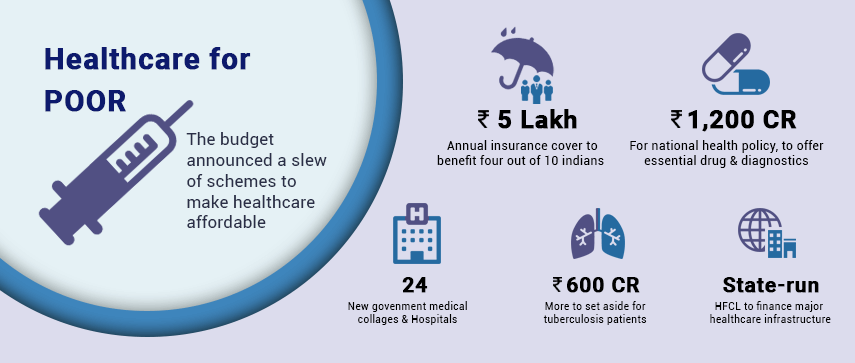India stands today at the brink of an impending health scare. While, internationally, healthcare is progressing leaps and bounds, India still remains at the back-foot, with a menial GDP contribution of about 1.3% on healthcare in the country, against the global average of 6%.

There is an alarming rise in the amount of non-communicable diseases, that’s become chronic over the years. This category of illness, referred to as NCDs, accounts for a fearful 60% in the total mortality rate in India today. The ever-increasing pace of lifestyle that is being led by many urban citizens of modern India, along with the massive migration of rural area dwellers resulting in slum-development has collectively given rise to unhygienic and unhealthy living conditions. Among several courses of treatment and cure, pharmacology is undoubtedly the most widespread and commonly used method. What’s challenging, however, is improper dispensing and distribution of medication.
Some noteworthy points observed here are:
-
Drug Administering and Adherence:
There is a great deal of negligence observed with respect to medical therapy, which accounts among the leading challenges faced by the healthcare sector today. Improper or erratic adherence to prescribed medical treatment leads to a horde of further medical complications. In extreme cases, such can result in worsening and even death due to incomplete eradication of the causative factors. This presses one to question the reasons for a patient, especially a serious one, would discontinue or disturb the advised pharmacology course.
-
Rampant Disregard:
Improper knowledge and awareness about the effects of the prescribed medication lead patients to make uninformed decisions about the course and nature of medication. Some patients even practice self-medication, further degrading the case of illness.
-
Limited Access at Sky-rocketing Prices:
Difficulty to access proper medical resources, prices in the unaffordable range for patients from lower economic strata, very high waiting time or longer queues in functioning pharmacies or medical stores are among the top points why patients often show negligence in the administration of the necessary drugs.
-
Poor Assistance to Incapable Patients:
Issues such as seclusion of the aged and needful, due to the emergence of a nuclear family system, unavailability of proper stores in rural, remote and inaccessible areas only add up to the base problem. The high prevalence of meager medicine adherence and resultant complications can be accounted for these issues.
Technology is the campfire around which we tell our stories.-Laurier Anderson
Today, technology has gone way further than simply touching our lives, pervading just about every aspect and dimension surrounding us. In most of these aspects, the effect of technological interference has been a positive and developmental one. Among these aspects, healthcare still remains comparatively untouched by technology, with its footsteps very slyly entering the field in the last couple of years. Thus, it would be safe to say that technology, especially the internet has a great potential in the applicable and demanding field of healthcare. The concept of online pharmacy and the e-pharma revolution could be just the next step needed to achieve a sustainable and stable medicine circulation.
The E-pharmacy Revolution – A Step Towards Better Medication

E-commerce and online retail stores are on an all-time hike! The reason is simple – Internet use for the purpose of shopping and buying has brought a vast range of products at literally one’s fingertips. What’s more, this has become a matter of improved lifestyle and higher standards of living, over being just a luxury or convenience step.
The obvious progression of this trend is expected to be seen in the pharmaceutical and medicine sector. While this is already a well-established trend in the United States and the majority of Europe, it’s a rather novel and emerging field in India.
How Introducing E-pharmacy in India Would Be a Revolution?
- Several patients have a high state of dependency on others, especially family members or domestic help when dealing with the purchase and consumption of medication. This, along with poor accessibility to pharmaceutical retailers, is a sparkling cause for the rise in online pharmacy.
- In the e-pharmacy model of medicine propagation, the consumer has facilitated access and availability, with improved tracking of the necessary medication possible for a particular patient.
Introducing e-pharmacy into the currently grappling healthcare system in the country would mean the large-scale inclusion of masses, irrespective of their social and geographical location. - The price range and offers made available by e-pharma platforms are highly competitive, making it very likable for consumers from all economic backgrounds and walks of life.
- One can find a wide range of medicals products, at arguably the most reasonable prices and delivered at one’s footsteps, just at the click of some fingertips.
- As one can anticipate, this will only be propagated further as a trend, with an expected 5-15% market dominance of the e-pharma culture in the gross pharmaceutical annual sales of the country, in the upcoming years.
- E-pharmacy emergence in India could pave the way for a unified online healthcare management system, with parity for all.
- What can be envisaged from a current or expectant retailer point-of-view is a potential sales gold-mine developing in the form e-pharma sector.
What more could an ailing person ask for? E-pharma can become the ultimate module of streamlined medical sales along with facilitated patient care and customer satisfaction, making it a win-win for the retailers as well as consumers.
E-pharmacy: Some Common Models
Similar to the e-commerce platforms which have become exceptionally popular in India, e-pharmacy too can be found under some fixed model systems. These models are based on the variety of their stocks and distribution patterns.
Some common models found in the e-pharmacy sector are:
- Inventory-based Model of E-pharmacy:
The inventory of drugs and services is self-owned and operated by the e-pharmacy platform itself. No third-party involvement is observed here. - Marketplace-based Model of E-pharmacy:
In this model, a number of pharmaceutical retailers and stockists share a common digital platform, which connects them with end-consumers through a network and provides an interface between the two. - Generic E-commerce Model:
The general departmental store in a digitized form sells just about everything under one roof, or here, one platform. This includes sales and distribution of prescribed medicine and related pharmaceutical products.
These models can be broadly classified into two vast categories:
-
Organized E-pharmacy
- The market-place model that is a common platform for the nearby group of pharmacy retailers
- The inventory model, which is the online platform of a licensed, offline pharmacy
-
Non-organized pharmacy
Here, the sale of pharmaceuticals and drugs is rather loose. There is fewer or sometimes no restriction and validation over the prescription of the drugs ordered in this model. This lowers the authenticity and reliability of the drugs purchased here, thus making them a rather avoidable option for buying medicine.
Indian Regulation for E-pharmacy
- The governing and regulatory structure for prescription drugs in India is two-tiered. The power to regulate these has been distributed between the Central government and State governments.
- The Central government mainly look over the licensing of imported drugs and pharmaceutical products in the country. Manufacturing, sale and, distribution of the drugs is the responsibility belted under the state governments.
- Each state has an appointed state drugs controller that has the power to exercise in terms of regulations applicable to several drugs manufactured and sold in the respective state. This comes under the Drugs Control Administration of each state.
- The Drugs and Cosmetics Act, 1940; Drugs and Cosmetics Rules, 1945; Pharmacy Act, 1948; Indian Medical Act, 1956 and Code of Ethics Regulations, 2002 are some of the prominent laws that govern the regulation and circulation of drugs and related pharmaceuticals in India.
- The noteworthy point here is that these laws do not consider the concept of e-pharma. Currently, all the activist related to computers, the Internet and networking are managed by the Information Technology Act, 2000.
Due to lack of accounting for e-commerce, especially e-pharmacy, there is some scope and freedom of interpretation of the laws currently prevalent. One can, however, expect to see relevant amendments in the near future, especially with the emergence and expected a rise in popularity of e-pharmacy in India.
The Government’s Plan of Action
As seen earlier, the lack of existing rules in the field of and for the regulation of e-pharmacy have potentially become a loophole in the industry. The government cannot possibly afford to take risks in a field as vulnerable as healthcare and hence it restricted sale by e-pharmacies earlier. The Drugs Controller General of India (DGCI) has appointed Federation of Indian Chambers of Commerce and Industry (FICCI) as a central, governing agency in respect of all matters related to e-pharmacy in India. This agency is working in developing, what may be said as the very first structure of regulations for the e-pharmacy sector in India, as an innovative model of medicine sale.

The government is making relevant efforts by including key points in the recent budget to make healthcare accessible and affordable. The establishment of FICCI as the regulatory board for faster facilitation and setup of e-pharmacies in India could be a major step in that direction.
Conclusion
What can be observed so far in this sector is that the e-pharmacy revolution could be the next giant step in the way of better living and push the envelope we have been carrying in the name of a developing nation. There are some major amendments and changes expected in the laws governing the same and one can expect better prospects, as a retailer, in terms of e-pharmacy very soon. Delve right into the progressing field of restructured healthcare – e-pharmacy!
Author's Bio

Shailendra Sinhasane (Shail) is the co-founder and CEO of Mobisoft Infotech. He has been focused on cloud solutions, mobile strategy, cross-platform development, IoT innovations and advising healthcare startups in building scalable products.







